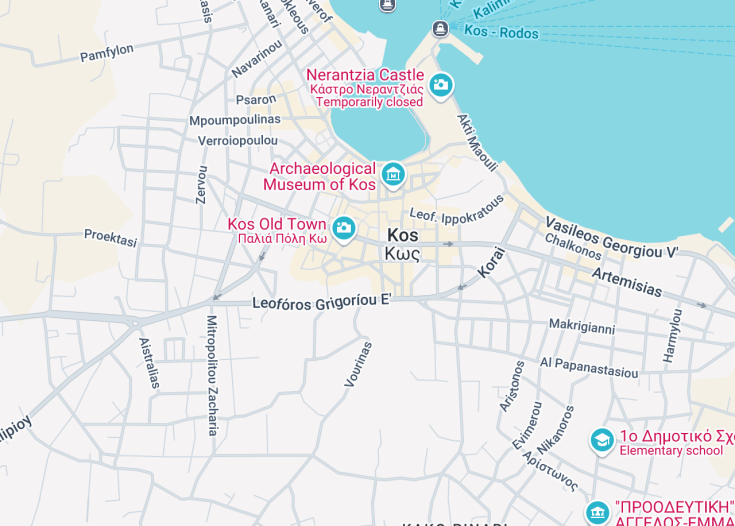Kos, a gem in the Dodecanese island chain of Greece, offers a captivating blend of beautiful beaches, ancient ruins, and vibrant cultural heritage.
This idyllic island is renowned for its white sandy beaches like Tigaki, historical sites including the ancient Agora and the Roman Odeon, and the lush mountain landscapes that are ripe for exploration. Kos also serves as a culinary haven, offering an exquisite mix of traditional Greek and Mediterranean cuisine.
For the best experience, visit Kos during late spring or early autumn to enjoy pleasant weather and fewer crowds. This timing allows for a more relaxed exploration of the island’s rich cultural and natural landscapes.
Pack comfortable walking shoes and explore Kos by bike. The island offers numerous well-maintained paths that meander through picturesque villages and historic sites.
Top things to do & see in Kos
Select the following sights and activities to discover best tickets and tours available in Kos.
Kos: A Gem in the Aegean Sea
| Country | Greece |
| Time in Kos | GMT+2 |
| Language spoken | Greek |
| Population | 33,388 (source: latest available data) |
| Currency | Euro (€, EUR) |
| Airports |
|
Kos, a captivating island in Greece, is steeped in history and bustling with life. Located in the southeastern Aegean Sea, it forms part of the Dodecanese island group. Known for its rich historical heritage, Kos has been inhabited since ancient times, evident from the well-preserved ruins and archaeological sites that dot the landscape. The island served as an important trade and cultural bridge between civilisations throughout history, including Greeks, Romans, Byzantines, and Ottomans.
Modern Kos combines its historical allure with vibrant contemporary life. The capital, Kos Town, is a tourist hotspot with an enchanting blend of ancient architecture and modern amenities. Visitors can explore the ancient Agora, the castle of the Knights of Saint John, or relax in one of the many cafés and restaurants. The island is also famed for its beautiful beaches like Tigaki and Paradise Beach, making it a popular destination for sunseekers and history enthusiasts alike.
Where is Kos?
Located in the Greek Islands, Kos lies in the heart of the Dodecanese chain in the Aegean Sea, close to the Turkish coast.
Distances:
| Route | Distance by car | Time by car |
|---|---|---|
| Athens to Kos (via ferry from Piraeus) | Approx. 300 mi (483 km) | 9-10 hours (including ferry transit) |
| Thessaloniki to Kos (via ferry from Piraeus) | Approx. 700 mi (1127 km) | 16-17 hours (including ferry transit) |
What is Kos famous for?
Kos is renowned for its beautiful sandy beaches, historical sites, including the ancient Asclepeion, and being the birthplace of Hippocrates, the father of medicine.
History
3000 – 1100 BC: Early Bronze Age and Mycenaean Period
The history of Kos dates back to the Early Bronze Age, around 3000 BC, when it was inhabited by the Leleges and the Carians, among other pre-Hellenic people. During this time, Kos flourished thanks to its strategic location and fertile land. By the 14th century BC, the island came under the influence of the Mycenaeans, who established settlements and integrated Kos into their extensive trade networks. The influence of Mycenaean culture left a significant impact on the local population, visible in pottery and other artifacts discovered on the island.
1100 – 500 BC: Dorian Settlement and Archaic Period
After the collapse of the Mycenaean civilization, Kos was settled by the Dorians, who established the city of Astypalaia. During the Archaic Period, Kos became a significant part of the Dorian Hexapolis, a confederation that included Halicarnassus, Knidos, Lindos, Ialyssos, and Kamiros. This was a time of cultural growth, with strong connections between Kos and mainland Greece. The island began to emerge as a center for healing, largely influenced by the worship of Asklepios, the Greek god of medicine.
500 – 336 BC: Classical Period and Persian Occupation
Kos played a crucial role during the Persian Wars. In the 5th century BC, it was occupied by the Persians but later joined the Delian League led by Athens after their defeat. The Classical Period was marked by economic prosperity and cultural growth, largely driven by its thriving wine and silk industries. During this period, Kos also became famous for its medical school, established by Hippocrates, the father of modern medicine, who was born on the island around 460 BC.
336 – 146 BC: Hellenistic Period
Following the conquests of Alexander the Great, Kos entered the Hellenistic Period. It benefited from a close alliance with the Ptolemies of Egypt, which turned the island into a prosperous trading hub. The famous Asklepieion, a sanctuary and healing center, was constructed during this time and attracted patients from across the ancient world. Kos became renowned for its intellectual and artistic contributions, with the medical school gaining widespread fame.
146 BC – 395 AD: Roman Period
Kos came under Roman control in 146 BC, entering a period of relative stability and prosperity. The Romans greatly valued the island’s strategic position in the Aegean Sea, and its status as a center of medicine continued. Kos was granted the status of a free city, which allowed it some autonomy under Roman governance. The Asklepieion continued to function as a major center for healing and learning, while Roman infrastructure projects further improved the island’s prosperity.
395 – 1309 AD: Byzantine Period
After the division of the Roman Empire, Kos became part of the Byzantine Empire. Christianity spread across the island, and churches were constructed over earlier pagan temples. The island suffered from occasional pirate raids and earthquakes, but it remained an important regional center throughout the Byzantine era. Fortifications were built to defend against Arab incursions during the 7th and 8th centuries.
1309 – 1522 AD: Knights of St. John
In 1309, Kos was taken over by the Knights of St. John, who had established their power in the region. They fortified the island, constructing impressive castles such as the Castle of Neratzia in Kos Town, to defend against Turkish invasions. The rule of the Knights brought relative stability, but the island faced numerous attacks from both the Ottomans and pirates.
1523 – 1912 AD: Ottoman Rule
The island of Kos fell to the Ottoman Empire in 1523, starting nearly four centuries of Ottoman rule. During this period, the population of Kos consisted of both Christians and Muslims, coexisting under Ottoman governance. The island experienced phases of hardship but also benefited from agricultural productivity and trade. The influence of Ottoman architecture and culture can still be seen in some of the island’s historic structures.
1912 – 1948 AD: Italian, German, and British Occupation
In 1912, Kos was captured by Italy during the Italo-Turkish War, becoming part of the Italian Dodecanese. The Italians invested in infrastructure, restoring archaeological sites and building new structures. During World War II, Kos was occupied first by the Germans in 1943 and then by the British in 1945. Finally, in 1948, Kos, along with the rest of the Dodecanese, was united with Greece.
1948 – Present Day: Modern Era
Since joining Greece in 1948, Kos has undergone significant development, especially in tourism. Its rich history, beautiful beaches, and archaeological sites have made it a popular destination for visitors from around the world. Today, Kos is known for its blend of ancient and modern attractions, including the remains of the Asklepieion, medieval castles, and vibrant local culture, which draws on influences from its diverse historical past.
Visit Kos
What to see and do in Kos
The island of Kos offers a range of attractions and experiences for its visitors. From its rich historical sites, like the famous Asklepieion and the Castle of Neratzia, to its lovely beaches such as Tigaki and Agios Stefanos. Visitors can explore the Ancient Agora, soaking up centuries of history, or take leisurely bike rides along the scenic routes lining the coast.
For nature enthusiasts, the Psalidi wetland provides a unique ecological area to observe diverse wildlife species. Last but not least, Kos town itself is a vibrant mix of history, culture, and modern comforts, featuring an array of shops, cafes, and traditional tavernas.
Festivities in Kos
Kos boasts several cultural events and festivities that highlight its rich heritage and vibrant community spirit. Notable among these is the Hippocratia Festival, a summer-long celebration with a variety of cultural events ranging from music concerts to traditional dancing and art exhibitions, held predominantly from July to August.
Another significant event is the Kos International Road Cycling Grand Prix, which takes place in April and attracts athletes and sports enthusiasts from around the world.
Best time to visit Kos
The ideal time to visit Kos is between late spring and early fall, from May to October, when the weather is most agreeable and conducive to exploring the outdoors and participating in various festivals. During these months, the temperatures are warm, perfect for beach activities and island excursions.
Is Kos worth visiting?
Kos is undoubtedly worth visiting due to its impressive blend of historical sites, beautiful landscapes, and lively cultural scene. This Greek island offers a unique perspective on ancient Greek history meshed with the luxuries of modern tourism.
Whether you are a history buff, a nature lover, or someone seeking a relaxing vacation spot, Kos caters to all preferences, making it a rewarding destination for many travelers.








